
10
make a wish!
41
Celebrating the Abundance of Local Foods in Southern Wisconsin Summer 2020. Issue Number
Member of Edible Communities




about the cover:
Take a breath and make a wish: Ms. Edna's Very Good Chocolate Cake baked by Monica O'Connell. Photography by Tracy Harris - see Last Bite for more.
6 Notable Edibles by Lauren Langtim
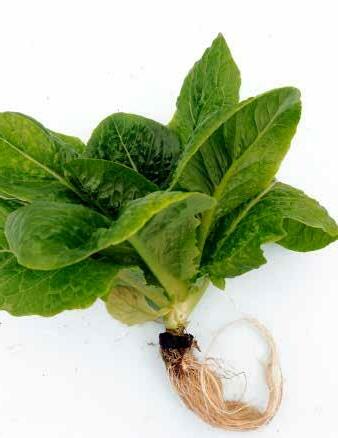



8 Turning Ten in a Time of Transition Revisiting ten articles with a look at the past, present and future in our region by Wendy Allen and past contributors 33 Recipe Roundup Favorite recipes from ten years of Edible Madison by Dani Lind and past contributors 46 Supporters Advertisers Index 48 Last Bite by Monica O'Connell

summer 2020 • Issue 41
Photo by Jim KLousia
With this issue, we celebrate a decade —40 seasons—of publishing Edible Madison! When our first issue hit newsstands in summer 2010, we never imagined how amazing the journey would be to publish this magazine across so many years and seasons.
Back then, we were inspired by the impact the network of independent Edible Communities publications was having across North America. We believed it was very important for Wisconsin, a true pioneer in the local, organic foods movement, to be represented.
When we first set out, before our first issue saw the light of day, many leaders of our region’s food and farming movement showed us support—through sharing their editorial ideas, agreeing to be contributors, committing to advertise with us, and simply giving us words of encouragement. This support network never wavered, and it provided the fuel we needed to steadfastly shepherd this publication and use the power of storytelling as a vehicle for positive change. As we pass the baton to an incredible new team, I’m deeply grateful for each person who believed in us and the mission of this publication over the years.
That mission has been to promote that eating locally is good for our economy, environment and health, and to connect eaters with local, organic food sources. We have done this through telling the stories of the local farmers, food producers, chefs, educators and forward-thinking organizations behind our region's dynamic food movement. We have seen firsthand that knowledge is power. When people know the true story behind their food, they can be inspired to shift their buying power in support of a sustainable food future.
As we look to that future, we recognize we are living in unprecedented times. This year has brought immense challenges and change on so many levels. Our food community has been hit hard. Our resilience is being tested. But if there’s one thing I know, it’s that our food community is strong, and we will recover. Together, we will look back on this time as one of deep challenge, learning and growth—a time that invited us all to look inward and discover opportunities to see and do things differently, to change our outlook, to expand our understanding, and to do better. We can and we will do better. Through remembering our interconnectedness, we will ultimately dismantle a very broken system and replace it with one that upholds sustainability, equity and justice. I believe, with the true spirit of community, we can do this.
This spirit of community is at the heart of the team taking the reins of Edible Madison from here forward. I’m thrilled to transition the magazine to Christy McKenzie and Cricket Redman, who are joined by Lauren Langtim as the managing editor of Edible Madison. They are incredibly talented and deeply dedicated to the mission of this magazine, and I’m proud of the foundation we built for its future in our Southern Wisconsin region. I eagerly look forward to cheering them on and know they will infuse it with incredible energy and creativity that will take it to new heights. Here’s to the next decade and beyond!
As I sign off as publisher and editor-in-chief and transition to number-one fan, I am filled with deep appreciation for every person who has contributed throughout the years. I’m profoundly grateful for our core team members, who have all been with the magazine for its entire ten years: Wendy Allen, contributor and copy editor; Terese Allen, editorial advisor and columnist; Dani Lind, culinary advisor and columnist; and Jim Klousia, creative director.

And a special note to Jim: Thank you. Thank you for everything you poured into bringing this magazine to life, season after season. Thank you for believing in this, for your vision and for your passion. Without you, it would not have been. I’m fortunate to have walked this path with you at my side, and I know so many others feel the same.
With gratitude,
publishers' letters
2 Summer 2020
Jamie Lamonde, Founder
Cheers to 10 years! I’m so grateful to Jamie and her team for what they have created in Edible Madison over the past decade. Jamie’s dedication to our region’s foodshed and her devotion to the people who make up our local food community is evident on every page of every issue. Steering the ship through 40 seasons is certainly an accomplishment worth celebrating. She has mentored me through the transfer of ownership of the magazine and for that I am indebted to her. Christy, Cricket and I have relished working with Jamie and the rest of her team on this jointly produced 10th Anniversary issue.
When we first started planning this issue, I could never have imagined how different life would look just a few months later. Before, we took so much for granted. The buzzy hum of a packed restaurant. Squeezing through a crowded bar, hoping to catch the bartender’s attention. Quick, carefree trips to the grocery store or the winter farmers’ market, just to pick up a few things. Greeting friends and family with hugs, sharing air, sharing drinks, sharing food.
For a moment mid-quarantine, it felt as though rampant banana bread baking and tending to the needs of infant sourdough starters were perhaps the only things keeping us from slipping into collective insanity. But isn’t it encouraging that when forced to slow down and consider what is truly essential, feeding our loved ones floats to the top of the list? This return to the kitchen gives me hope that our local food system will rebound, forever changed but stronger than before. Regardless of what is happening in the wider world, there is always a yearning for good food that nourishes bodies and the planet.
As we live through a still-unfolding revolution for racial justice, we’re hopeful that we will see meaningful change in our society as a whole, and it starts with us, as individuals, examining what role we can play. Together with Cricket and Christy, our team has been reflecting on what we can do to aid in the dismantling of systemic racism, especially as it relates to our food system. We commit to continually and proactively diversifying our pool of contributors. We invite everyone in our community, especially BIPOC, to submit editorial ideas. Visit www.ediblemadison.com/work-with-us to learn more.

There are so many worthy stories to tell right here in southern Wisconsin that even 41 issues in, Edible Madison has barely scratched the surface. We look forward to bringing in fresh storytellers to help us propagate the good food movement!
Recent events may have rocked the world, but instead of waiting for things to go back to normal, let’s begin again. Let’s leave behind what was no longer serving us and come back stronger than before. Here’s what I know: We are hungry. Hungry for a more just and equitable world. Hungry for food that nourishes our bodies and our communities. Hungry for food that reflects our values. Hungry for food that connects us to our neighbors.
Let’s dig in.
Lauren Langtim, Managing Editor

ediblemadison.com 3
Jamie has worked in the world of organic and sustainable food and farming for her entire career and has a deep commitment to nurturing positive social change through values-driven marketing and public outreach. In 2010, she founded Edible Madison , a magazine that celebrates the abundance of local foods in Southern Wisconsin. Jamie lives in the beautiful Driftless Region of rural Wisconsin with her two sons and continues to be inspired, and inspire others, through the good food movement.
Jim Klousia
Jim holds a degree in communication and journalism degree from the University of Wisconsin, Eau Claire. A Wisconsin native, he is a local adventurer who loves food, photos, and a good wheat beer. He is passionate about enjoying food with others and capturing live in Southern Wisconsin through photography.
WENDY ALLEN
Wendy Allen is a copy editor, writer, digital editor and writing workshop facilitator. She reads style guides for fun, believes stories have power, and is fascinated by the evolution of the English language—for better or worse. Her mission: to wrestle the wily comma into submission.




MANAGING EDITOR
Lauren Langtim
PUBLISHERS
Christy McKenzie Cricket Redman
CREATIVE DIRECTOR Cricket Redman
LEAD PHOTOGRAPHER
Jim Klousia
COPY EDITOR Judith Woodburn

CULINARY ADVISOR Christy McKenzie
SOCIAL & DIGITAL PRODUCER Lauren Ruedersdorf
CONTRIBUTORS

Jamie Lamonde Jim Klousia Wendy Allen Dani Lind
ADVERTISING, SPONSORSHIPS & EVENTS
Monica is a scholar, writer, pastry chef, and owner of Curtis & Cake, a work space for exploring culture, community, and connection at the dessert table. She believes chocolate cake is an important part of a balanced diet.
Dena Alspach 612-978-0084 dena@ediblemadison.com
CONTACT USEdible Madison 4313 Somerset Lane Madison, WI 53711 hello@ediblemadison.com
SUBSCRIPTIONS
DANI LIND
Dani owns and operates Rooted Spoon Culinary, a farm-to-table catering service and event space/bar in downtown Viroqua that focuses on locally sourced and seasonal menus and cocktails. When she’s not in the kitchen, she’s working up an appetite helping her husband with their grass-fed beef operation, gardening, or hiking/paddling/biking/skiing with her border collies.
Terese Allen
Terese Allen has written scores of books and articles about the foodways of Wisconsin, including the award-winning titles The Flavor of Wisconsin and the Flavor of Wiconsin for Kids . She is co-founder and longtime leaer of the Culinary History Enthusiasts of Wisconsin (CHEW). If you want to get Terese going, just ask her the best way to fix an old fashioned, how to hunt for morels, or why fish fries thrive in our state.
Tracy Harris

Tracy is a graphic designer and photographer from Madison, Wisconsin A polymath at heart, she dabbles in various arenas of makery including cooking and baking, sewing and knitting, painting and collage, and has a soft spot in her heart for film photography. When she’s not busy making things, she enjoys travel, good food & drinks, gardening, and live music.
And david Nevala (not pictured) is a commercial photographer, avid angler and Dad based in Madison, Wisconsin.

ediblemadison.com/subscribe hello@ediblemadison.com
We want to hear your comments and ideas. To write to the editor, use the mailing address above or email hello@ediblemadison.com.
Edible Madison is published quarterly by Forager Publishing, LLC. All rights reserved. No part of this publication may be used without written permission by the publisher. ©2020.
Subscription rate begins at $25 annually. Every effort is made to avoid errors, misspellings and omissions. If, however, an error comes to your attention, please accept our sincere apologies and notify us. Thank you.
Monica O'Connell
Jamie LaMonde
4 Summer 2020 contributors




GOOD FOOD FINDS A WAY
The pandemic has catapulted our local food system into uncharted territory, but our foodshed is resilient. Farmers, provisioners, and producers are pivoting their business models in response to our shifting needs.
Farmers’ markets continue to connect local eaters to local foods in new and creative ways. Restaurants are cautiously opening their doors and adapting to serve what we’re craving now: community!
Forward provisions // FORWARDPROVISIONS.COM »
Forward Provisions connects small, local food producers to customers in the Madison area through weekly delivery of high-quality, artisan foods. Created by the folks at Quince and Apple in response to the disruption caused in our industry by COVID-19, Forward Provisions keeps the local food economy vibrant and strong during these challenging times. Products include award-winning sausages and preserved meats from Underground, baked goods from Bayk, preserves from Quince and Apple, and more.
Victory Cheese Box // VICTORYCHEESE.COM
A group of volunteer cheese professionals created this grassroots initiative to support American specialty cheese amid the instability of the pandemic. Uplands Cheese has curated a Victory Box featuring their own cheese as well as cheese from other Wisconsin cheesemakers. Landmark Creamery is offering a Victory Box of products from female cheesemakers, fittingly titled “Milk Mavens: Women Who Work Whey Hard.”
Vitruvian Farms // VITRUVIANFARMS.CO M
Vitruvian has been growing for restaurants, their CSA, and local co-ops for 10 years. At the onset of COVID-19, they quickly pivoted to offer online direct-to-consumer sales, with free home delivery for orders over $60. They’ve expanded the offerings of their online store by partnering with other local producers such as Driftless Organics, Madison Sourdough, Ledger Coffee, Cadre, and Heritage Tavern.
Landmark Provisions // LANDMARKCREAMERY.COM

The Annas of Landmark are going above and beyond cheesemaking and cheesemonger duty, bringing the farmers’ market to your door with special local delivery of local goods, seasonal produce, lush artisanal cheeses, and more.
Brix Marketplace // BRIXMARKETPLACE.COM
The fine folks at Brix Cider have kicked things up a notch to make sure folks within a 10-mile drive of Mt. Horeb will stay well fed and well watered, with local pantry provisions, produce, meat, home goods, and, of course, their delicious cider. Check out their new online market.
STILL CRAVING A DOWNTOWN MARKET MOMENT?
L'EToile AND Graze // LE TOILE-RESTAURANT.COM Fromagination // FROMAGINATION.COM
Even if the Dane County Farmer's Market has moved to the Alliant Energy Center, you can still visit the Capitol square for Meal kits, family picnics, and pastry boxes (and magic coffee!) outside Graze and L'Etoile. Stroll around the square to Fromagination, where you'll find Wisconsin cheese and supplies for a perfect picnic.
Dane County Farmers’ Market // DCFM.ORG
The DCFM is hosting three local food pickups weekly at Willow Island at the Alliant Energy Center for the foreseeable future. Patrons pre-order via the WhatsGood online farmers’ market store. Show up at your appointed pickup time, drive through the market and farmers will place your orders in your vehicle. To get started, download the WhatsGood app or create an account at sourcewhatsgood.com.
LOCAL MARKETS ARE OPEN FOR BUSINESS IN NEW WAYS, NEAR YOU
Madison and La Crosse // Visit farmfreshatlas.org to find neighborhood farmers’ markets near you.
Janesville // JANESVILLEFARMERSMARKET.COM Saturdays 8am-1pm
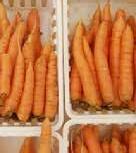
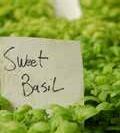
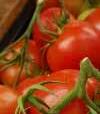
Viroqua // VIROQUA-WISCONSIN.COM/VIROQUA-TOURISM/FARMERSMARKET Saturdays 8am-Noon
New Glarus // Fridays 3-6pm
Monroe // Saturdays 8am-1pm
Spring Green // Saturdays 8am-Noon
6 Summer 2020 notable edibles
June 9, 2020
A Love Letter to Our Food Workers
Read the full article at ediblemadison.com
A TI ME FOR ACTION
We're in a time of action. listening, organizing, thinking and helping find a better way forward.
40 Acres and Mule project
Adrian Lipscombe, owner of Uptowne Bakery and Cafe in La Crosse, is on a mission to raise $100,000 to buy agricultural land that will serve as “a sanctuary to hold the history, food, and stories of Black culture in food and farming.” The project arose organically through conversations with her local community, and she’s now well on her way to her goal. At the time of this printing, the gofundme campaign has reached $75,000.
“My vision is to have a sanctuary to hold the history, food, and stories of Black culture in food and farming. This land will be used to teach others how to farm, archive Black food ways and to communicate the importance to Black farms.
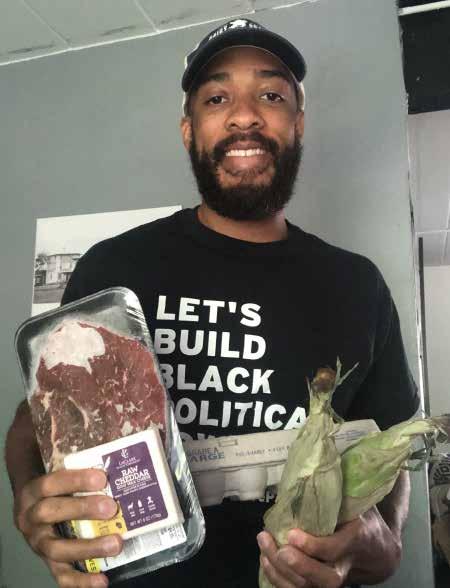
Follow on Instagram: @40acresproject
Contribute: gofundme.com/f/forty-acres-project
Bakers Against Racism

On June 20th local bakers and pastry chefs from Madison Chocolate Company, Bayk, Ugly Apple, The Looking Glass Bakery, Madison Sourdough Co, Pasture and Plenty and more got busy in their kitchens, baking to profit organizations that support Black lives. They joined 2,000+ professional pastry chefs and home bakers across the country and around the world to raise over $1.6 million for racial justice organizations. Started by Washington D.C. Chefs Paola Velez and Willa Pellini, as local pop-up bake sales in their community, this movement of sugar, flour, butter and salt gained fast momentum. Keep an eye out for more. We have a feeling this is just the sweet start of something bigger.
Follow on Instagram: @bakersagainstracism
Learn more: bakersagainstracism.com
 Adrian Lipscombe
Adrian Lipscombe
“We must recognize that the way we operate as a community, including our local food system, may never be the same. And while that can be a scary thought, it can and should provide an opportunity to do better than what we knew as the status quo.
Mandela Barnes, Lt. Governor
ediblemadison.com 7
Turning 10
in a time of Transitions
“We've created a special issue that is both a retrospective and future-focused view of our regional food system. What you’ll find within these pages is a result of carefully combing through our archive and selecting ten of our favorite and most pertinent past issues. For each, we revisit the issue’s theme or feature article, examine how it has evolved since then, and share insights for the future. We hope you enjoy taking a walk down memory lane with us, and that you are left feeling as inspired and dedicated to continuing to support all of the amazing and hardworking farmers, food producers, chefs, educators, forward-thinking organizations, and food system change-markers of our region as we are.

8 Summer 2020
Jamie Lamonde, founder
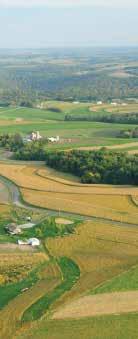
1 Brewing Community Local Brewers Share the Craft 3 BEES + HUMANS A New Era of Interdependence 5 Honoring our apple elders Wisconsin’s Rich History of Heirloom Apple Production 7 The meat of the matter The Challenges of Local Slaughtering and Butchering 9 embrace the darkness Daunting and Delicious: Eating Locally through Frigid Wisconsin Winters 2 Local Coffee Roasters Promote Fair Trade The Rocket Trajectory of Specialty Roasters 4 Sharing the bounty Neighbors Feeding Neighbors: Fighting Hunger in our Communities 6 Agriculture and Environmental Conservation Contour Farming to Regenerative Agriculture 8 WATER Exploring fresh water protection in our region and the economic and environmental impacts on our food system 10 our restaurant community Resilience in the Face of a Pandemic ediblemadison.com 9
Brewing Community
Local Brewers Share the Craft
Then
2010 was a special year. At the summer solstice, the height of the sun and of the year, we toasted the launch of Edible Madison’s first issue with bottles of cold, local, craft brews. No other drink would have been appropriate to celebrate a cover featuring a handful of green hops that you could practically smell off the page.
At that time, the brewing community in Madison was a small and close-knit group made up mostly of men who got their start as home brewers. It was a joy to re-read this article 10 years later. We’d forgotten the story of “Frankenstone,” a tasty and aptly named beer jointly brewed by Capital, Great Dane and Lake Louie, “which involved heating rocks and other strange science.” The brewers tried recreating it a year later, and instead of being “one of the best five beers” they’d ever tasted, it blew up. Since that first issue, we’ve written about beer in 11 of our 40 editions.
Now
The brewers mentioned in this article 10 years ago have become the elders of a craft beer scene exploding with new faces, yet the original culture of community, camaraderie and cooperation remains strong. Established brewers have long shared their wisdom and equipment with newbies, helping them keep quality high and overhead costs low during those risky startup years. Notably, more women brewers have been welcomed into the community, led by Jamie Baertsch, of Wisconsin Dells Brewing Company, who became Wisconsin’s first female brewmaster back in 2005. In 2018, the women-owned Giant Jones Brewing in Madison became the state’s first certified organic brewery.
Shannon Henry Kleiber
1
“Because brewing beer is life and work and play all together, it is natural that many of the brewers have become friends.”
issue No. 1, Summer 2010
10 Summer 2020
Original article by Shannon Henry Kleiber
Future
It’s safe to say that the craft brewing scene in Southern Wisconsin is healthy and strong. It’s even spurred interest in whether Wisconsin can once again become a hotspot for growing hops (a “hopspot”?). The Wisconsin Hop Exchange cooperative, in particular, is working to build partnerships between local craft brewers and local hop growers, with the goal of reviving an industry that once was a huge part of Wisconsin’s economy and farming culture.
(Read more about the history of hops in our state in “Wisconsin’s Hops Renaissance,” from our Summer 2012 issue, also available online).

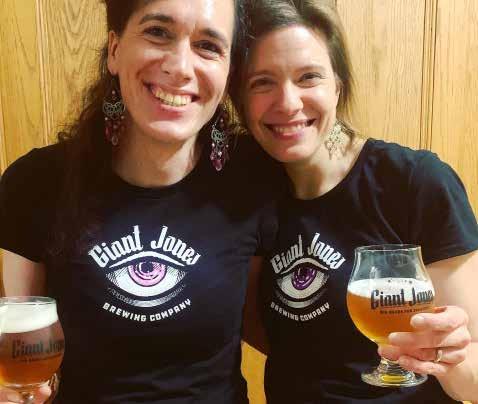
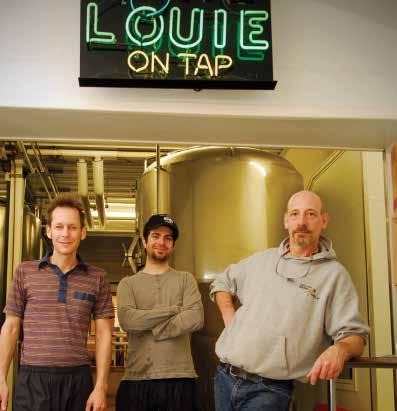
Alongside the genuine desire to see each other succeed, there’s still a sense of friendly rivalry that ensures our local brewers continually push their limits and try new ingredients and techniques. The result? We beer-lovers get a nearly unlimited selection of flavors to delight and challenge our senses. We can’t wait to see what Southern Wisconsin brewers come up with next.
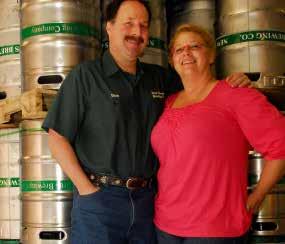 Left (top to bottom) Jessica and Erika Jones of Giant Jones, Staff Cleaning tanks at Lake Louie, Tom Porter, owner of Lake Louie Brewing with staff.
Left (top to bottom) Jessica and Erika Jones of Giant Jones, Staff Cleaning tanks at Lake Louie, Tom Porter, owner of Lake Louie Brewing with staff.
ediblemadison.com 11
Above: Deb and Dan Carey from New Glarus Brewing Co.
Local Coffee Roasters Promote Fair Trade

The Rocket Trajectory of Specialty Roasters
Then
Issue number three was one of our favorite covers for its simple yet symbolic composition. The process of cupping, represented in the cover photo, is an important part of sourcing great coffee. During a cupping, experienced tasters will try many coffee varieties in very little time, slurping their way down a long line of cups. With only a spoonful, they evaluate the coffee’s cleanness, sweetness, acidity, mouthfeel and aftertaste.
The cups here also symbolize the 23 members of Cooperative Coffees (itself represented by the 24th cup), a coffeeimporting cooperative that promotes sustainable farming and fair trade.
Now
Like beer, craft coffee has been on a rocket trajectory over the past 10 years, and our region is home to many roasters who are leading the way in sustainable sourcing and paying farmers fairly for their hard work. Two of the state’s most prominent roasters, Just Coffee in Madison and Wonderstate Coffee (formerly Kickapoo Coffee) in Viroqua, have gained national influence through their membership in Cooperative Coffees. In fact, in 2017 Wonderstate Coffee instituted the highest minimum published farmer pay price in the United States, which prompted others across the country to raise their prices too. It’s remarkable that a small roaster in rural Wisconsin can have that kind of impact. “It’s locavore-ism... from a distance,” wrote Shannon in the article.
issue No. 3 , winter 2010
The sustainable and fair trade ethic runs deep among Wisconsin’s small roasteries, from pioneers like Colectivo, Wonderstate Coffee, Just Coffee, JBC, True and Ancora, to newer entrants like Ledger and Kin-Kin in Madison, Badger Bros. in Platteville, Hawthorne and Stone Creek in Milwaukee, Ruby in Nelsonville, and Honest Roast in Eau Claire. They, and many others, are committed to doing business in a way that supports small farmers and ecosystems around the world.
Future
A study published in January 2019 in Science Advances found “at least 60 percent of all coffee species are threatened with extinction,” mostly due to climate change. Many species are not even preserved in seed banks or grown in protected areas. Over the next 50 to 80 years, coffee will become harder to grow, reducing quality and yields, reducing the variety of species to breed from, which eventually will hurt the flavor of the coffee that gets many of us out of bed every morning.

This is one reason why Cooperative Coffees is exploring options grown in Central America. Here, the varied landscape provides options, and the region’s unique soils can grow beans with distinct and interesting flavors. Plus, coffee grown closer to Wisconsin means fewer food miles for that cup in your hand.
Here's hoping the future of coffee continues to support small sustainable organic farmers and the many roasters in our region. It takes caring, conscious coffee-lovers like you to make sure that happens.
2 12 Summer 2020
Original article by Shannon Henry Kleiber
“Because
Wisconsin is not a coffee bean producer, these businesses are supporting local in a different, expanded way. They still employ locally and sell to local coffee shops, but the roasters’ fair trade business practices also support the rural, agrarian communities with whom they work. It’s locavore-ism...from a distance.”
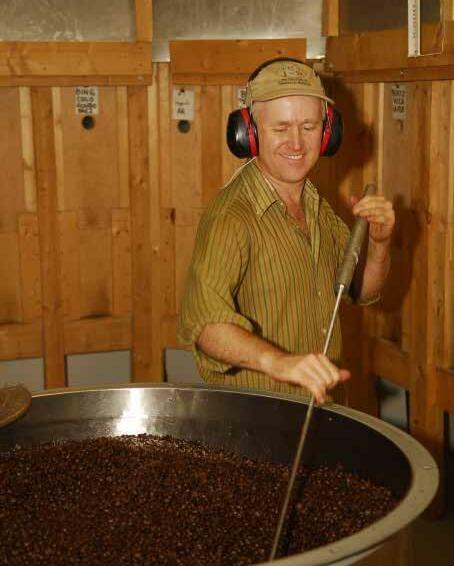 Shannon Henry Kleiber
Shannon Henry Kleiber
ediblemadison.com 13
Mike Moon formerly of Just Coffee < Caleb Nicholes, co-owner of Wonderstate Coffee
3 Bees + Humans
A New Era of Interdependence
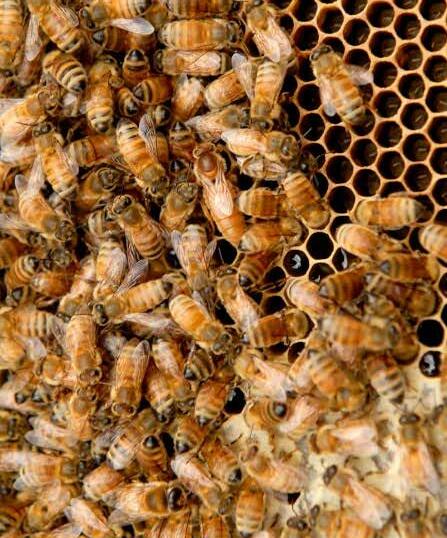
14 Summer 2020
“Bees depend on humans for survival as much as a healthy queen or a far-flying worker. We have become a vital part of their world.” Wendy Allen
Then
In 2011, we set out to explore the state of colony collapse disorder (CCD) in our state, but we were hard-pressed to find a beekeeper who had definitely seen a case of CCD or who was worried about it. The scientists we spoke with were concerned, but even their assessments of the causes and severity conflicted somewhat. As we dug deeper and talked to more people, we simply weren’t finding the high numbers of CCD-attributed hive losses that we thought we’d find.
Instead, the story morphed into an examination of the interdependence of humans and pollinators. We depend on each other—bees pollinate our crops, and humans provide habitat and keep the bees safe. “We’ve entered a new era of interdependence,” author Wendy Allen wrote, “as we realize just how much depends on some of the smallest creatures on our planet.”
NOW
According to the United Nations Food and Agriculture Organization, “Pollinators affect 35 percent of global agricultural land, supporting the production of 87 of the leading food crops worldwide.” The common honeybee is only one pollinator at risk—the majority of pollinators are wild, including wasps, butterflies, other bugs, and more than 20,000 species of bees. Scott Hoffman Black of the Xerces Society for Invertebrate Conservation says, “Unfortunately, the situation is still dire. Beekeepers are still losing up to 40 percent of their honeybee hives each year, and many native bees are on the brink of extinction.”
The problem goes beyond the single issue that sparked public interest in pollinators a decade ago. Pesticides, climate change, parasites, and habitat loss are each notable on their own, and combined, they can be devastating. Thankfully, interest and action to protect our tiny partners in the global food system remains strong to this day.
Hobby and professional beekeeping are up across our region, especially in urban areas. Bees actually thrive in cities, where flowers bloom early and more consistently throughout the season. Nathan Clarke of Mad Urban Bees writes on madurbanbees.com, “There are a lot of urban beekeepers in Madison, and we are a very pro-bee town. Madison has a very strong local food movement, and the bees help that local food system by providing pollination and great-tasting honey.”
Black says some things give him hope: “The rusty patched bumble bee was the first bumble bee to be protected under the Endangered Species Act. Interestingly, Wisconsin is a stronghold for populations of the rusty patched bumble bee, which provides more options for conservation.”
Public awareness of what individuals can do to support pollinators is high, but we can’t let our guard down. “We need to continue to be vigilant in keeping our honeybee colonies healthy and strong,” says Eugene Woller of Mt. Horeb-based Gentle Breeze Honey.
Issue No. 5 , summer 2011
In fact, Madison is a Bee City, an initiative of the Xerces Society, which means the city creates pollinator habitat on public lands and incorporates pollinator-conscious practices into city plans and policies. This work will continue to support these important creatures long into the future.
“Planting pollinator habitats and eliminating or limiting pesticide use are the two best things you can do for pollinators,” says Black. “In addition, we need people who will advocate to protect and restore parks and natural areas and advocate for their neighborhood association, city or campus to become pollinator-friendly.”
“There is tremendous interdependence between humans and pollinators,” Black continues. “One in three bites of food we eat comes from a pollinator, but on the flip side, if we do not ensure pollinators have high-quality habitat that is protected from pesticides, they will not be here to help.”
“It’s art and science combined,” says Woller. “We need to focus on the common value that unites beekeepers. There is a fascination with these marvelous, communal creatures whose pollination services benefit our food supply and, in turn, provide us with a wonderful byproduct of their industriousness: honey!”
Future
Bees + Humans
ediblemadison.com 15
Original article by Wendy Allen
Sharing the Bounty
Neighbors Feeding Neighbors: Fighting Hunger in our Communities
Then
The theme of this issue was, and still is, a topic dear to our hearts: neighbors feeding neighbors. There are so many examples of this kindness and compassion in our region. Madison Area Food Pantry Gardens grow literally tons of food to distribute to local pantries. Huge food bank warehouses like Second Harvest of Southern Wisconsin distribute food across our region. Benefit events like Empty Bowls bring awareness and empathy to the issue of local food insecurity and contribute money that’s used right in the community. Looking back, this work makes us so proud of our Southern Wisconsin neighbors.
Now
When we published this issue in 2011—just after the nation emerged from the 2008 recession— food insecure households had hit a record high. Food insecurity wouldn’t return to pre-recession levels until 2018—it took a decade to recover from a recession that lasted only a year and a half.
issue No. 7 , winter 2011
Original articles
Second Harvest by Maggie Messitt
Now, as the country teeters on the brink of another recession, efforts to contain the COVID-19 pandemic have put millions of Americans at risk of moving into—or deeper into—food insecurity yet again. Feeding America, a network that links the country’s thousands of food pantries, food banks, and meal programs, expects food insecurity in southwestern Wisconsin to increase by approximately 61 percent due to the pandemic. Between March and May, an estimated 63,000 more people in Southern Wisconsin became food insecure, many of whom were turning to the emergency food system for the first time in their lives.
Empty Bowls by Susan Gloss
Chef in the Classroom by Shannon Henry Kleiber
Farms to Families initiative. The boxes are filled with fresh, locally grown produce, protein and grains, including bread from the Neighbor Loaves program.
“This landscape is giving Roots4Change and REAP’s partnership an opportunity to re-appropriate the meaning of sustainable local food systems and shape it to a more equitable system based on mutual solidarity: farmers need to make a living and people deserve to eat wholesome food,” says Helen Sarakinos, executive director of REAP.
Food banks and pantries continue to be a hub during hard times, thanks to the people of Wisconsin who generously support them. Kris Tazelaar, director of marketing and communications for Second Harvest Foodbank of Southern Wisconsin, says the food bank and its network are here for the longhaul. “We are built to handle this kind of crisis as long as we continue to receive the kind of support we’ve gotten since the pandemic began. This level of support is truly inspiring, and it’s what makes the long hours worth it.
Future
As we head into summer, the season of sweat and dirt and plenty, we hope Edible Madison readers will find ways to support a relief organization that may be struggling to fill its schedule or shelves. Although the current situation makes it difficult to gather or volunteer in our usual ways, we must continue to share the bounty and support our neighbors generously and often.
School and childcare closures left around six million children across the country without the significant nutrition provided by free and reducedcost school meal programs. But on a positive note, many schools across the state continued serving bagged lunches to students in need.
We especially want to recognize the nonprofits that, without hesitation, stepped into the chaos to provide food and care to their neighbors. When shelves were bare of big-name flour, the Artisan Grain Collaborative launched a new initiative, Neighbor Loaves, to get bread baked with local grain into the hands of hungry people. Their participating bakeries churned out 10,000 loaves in just two months.
Roots4Change, a cooperative of Latina and indigenous community health workers, in partnership with REAP Food Group, have been delivering weekly “resilience boxes” to around 200 families through their
Volunteering at a food pantry garden or growing your own and donating it can be wonderful ways to support those in need while maintaining social distancing. Purchase a Neighbor Loaf through a participating bakery (graincollaborative.com/neighbor-loaves). Or contribute money if you’re able. Food banks can purchase food at less than retail prices, turning the $1 you would’ve spent on one can of green beans into $10 worth of food (secondharvestmadison.org/donate). Nonprofit organizations like REAP Food Group and so many others can turn your dollars into meaningful action.
“COVID-19 has exposed the cracks of our food systems in a painful way that I hope we can use as an opportunity for change,” says Sarakinos. “Groups like REAP have long spoken about the value of a resilient local food system for a strong community and economy. Maybe this is the time we can reinvest in our farmers and lands and soils and residents in a tangible and impactful way—to re-establish the backbone of a local food system.” We hope so.
4 16 Summer 2020


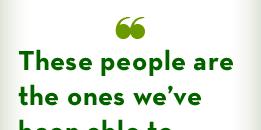
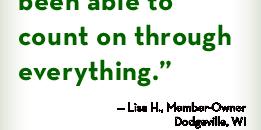
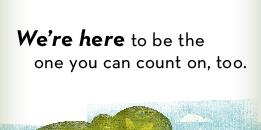








“We will be here to meet the needs of those facing hunger until the need is gone.”
Kris Tazelaar, Second Harvest Foodbank
Honoring Our Apple Elders
Then
Some sources say that at the turn of the 20th century, there were up to 15,000 known varieties of apple. At the time of this story in 2012, only 11 varieties made up 90 percent of commercial production. In contrast, many orchards in Wisconsin had begun bringing back old fashioned apple varieties—the flavorful “apple elders” displaced by modern cultivars like the Red Delicious, bred more for appearance and shelf stability than taste. The resurgence of “antique” apples at farmers markets and small groceries was driven by a new breed of shopper interested in unique flavors, including more tart options as home baking became popular again.
Wisconsin’s abundance of apple orchards dates to the early 1900s, when the Wisconsin Horticultural Society planted trial orchards around the state. The ones that thrived developed characteristics from the local soils and microclimates—apple terroir.
issue No.10, FALL 2012
Because many of Wisconsin’s antique apples were, and still are, hard to find, artist Bambi Edlund created lovely illustrations that perfectly captured the spirit of these old-timey apple offerings.
Now
Although only nine to 15 varieties (depending on the source) still make up the majority of commercial production, increased web searches related to heirloom apples in recent years suggest growing interest in more variety and better flavor.
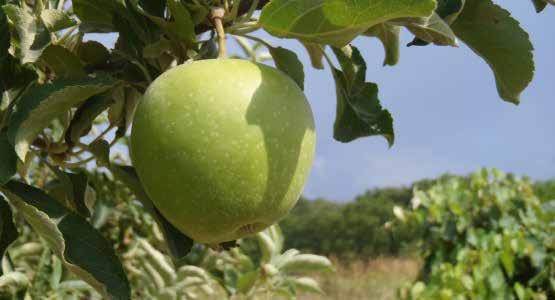
Weston’s Antique Apples, featured in our original story, remains the state’s premier producer of heirloom apples. Weston’s is the oldest active orchard in Waukesha County and grows more than 100 apple varieties, plus other fruit and berry crops.
In Wisconsin today, there are more than 6,500 acres of orchards, with more than 1,000 acres gracing the ridgetops and south-facing slopes surrounding Gays Mills in Crawford County. Driving around this area and popping into all
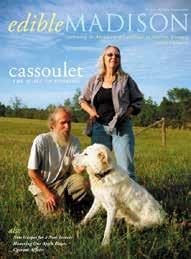
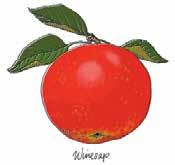
5
18 Summer 2020
Wisconsin’s Rich History of Heirloom Apple Production
Original article by Wendy Allen
the orchards, wandering among the trees, picking a bushel of fresh apples and examining the plethora of homemade goods in the shops is a wonderful way to spend a weekend.
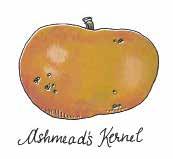
Future
Although we expect heirloom apple demand to remain steady as farmers markets, CSAs and food co-ops encourage local sourcing from smaller producers, there are some particularly hot topics surrounding these delicious orbs that we're keeping our eyes on.

Climate change is a critical issue for all Wisconsin agriculture, including our orchards. Climate shifts could open up new growing regions—or make current apple-growing regions unviable. Changes to local microclimates can also increase incidences of pests and fungi, further putting our state’s apple industry and biodiversity at risk.
Thankfully, our state’s apple industry is a forward-looking lot. The Eco-Apples Project of UW-Madison’s Center for Integrated Agriculture Systems works with local orchardists to help them reduce their reliance on chemical sprays by using multiple integrated techniques at once to address pests. The project is a wonderful example of information-sharing between veteran and new growers. The influx of new orchards, apple-product businesses, and solution-oriented programs in the region are all fantastic indicators that our apple industry is strong and the future is bright.
Consumers can support the rich heritage of apple growing in Wisconsin by choosing apples that are local or regional and produced using low-impact methods. Unlike the Haas avocado and Cavendish banana—both at great risk from pests and disease because they are grown in genetic monocultures—apples available in our region remain genetically diverse. If encouraged and protected, this diversity will ensure that these delicious and unique “apple elders” continue to delight future generations of apple-lovers.
Wendy Allen
“Once upon a time, there was no such thing as the Red Delicious apple…”
ediblemadison.com 19
Agriculture and Environmental Conservation
Contour Farming to Regenerative Agriculture
Issue No 14 , Fall 2013
Then
The lyricism of this story overlaid with dramatic aerial imagery drew us in once again. Author Jessica Luhning painted a vivid history of a unique and vulnerable landscape, its near destruction, and its restoration from 40-foot storm-eroded gullies in the 1930s to—only a few decades later—the gorgeous scene you see here.
Contour farming can reduce soil loss by 50 to 75 percent, keeping valuable topsoil on the ridges and hillsides rather than further muddying the Mississippi. When this article was published in 2013, Vernon County had more acres in contour than any county in the nation. Notably, National Geographic magazine photographed the area in 1995, gaining global recognition for the Driftless region.
Now
With dairy in oversupply and exports significantly down, Wisconsin’s agriculture industry is in crisis. In 2019, we led the nation in farm bankruptcies: more than 800 dairy farms went out of business—at a rate of more than two a day.
What does dairy have to do with contour farming and conservation?
The “buffer strips” that make contour farming effective consist of nonerosive crops like alfalfa, which provide hay for dairy cows. “The use of contour strips is dependent upon the health of the dairy industry,” said the article, and not much has changed since. It’s simply not financially viable to plant alfalfa without cows to eat it or dairy farmers to buy it. Farms that are still in business are tilling under buffer strips and removing contours to make way for more profitable corn and soy, and it’s entirely understandable. When your family’s immediate needs are at risk, you make tough choices to keep the farm afloat.
The promotion of no-till farming also contributes to the removal of strips. Although no-till farming does reduce soil erosion and is considered “sustainable” by industry standards, it truly only sustains. It doesn’t rebuild the land like perennial non-erosive crops grown in a contour system do, and its success relies on synthetic fertilizers and weed killers.
Future
“The Driftless is not suited for corn and soybeans or large livestock operations,” Jeff Hastings, a former Vernon County conservationist, said in 2013. “Instead, it presents an enormous opportunity for managed grazing”—an opportunity that many small, family-owned farms in Southern Wisconsin are taking advantage of, with plenty of consumer support. The demand for grass-fed animal products continues to increase as more and more people recognize the superior taste (and, studies are beginning to show, improved nutrition) of pasture-based meat, eggs and dairy.
Looking long-term, organic dairy and regenerative farming are certainly bright spots in the future of Wisconsin agriculture, with regenerative organic farming offering the greatest potential for both farm income and conservation of our soil, air and water.
Wisconsin is second in the nation for USDA Certified Organic farms, not even counting those that use organic practices but aren’t large enough to require certification. Organic practices work with the land, not against it; and on average, organic is more profitable, providing hope for many struggling farms.
Regenerative farming does exactly what its name suggests: regenerates the land, leaving it better than it was. In the original article, we contrasted a Wisconsin Historical Society photo of a dramatically eroded gully with an aerial photo of the same area in 2013. There’s no sign of the devastation from 80 years ago. It’s an incredible regeneration of the land.
Contour farming may have birthed the conservation movement back in the 1930s, but today, it’s one technique within the bigger picture of conservation-focused agriculture that goes beyond individual practices to include culture and values. And that’s reason for hope. “I see regenerative agriculture as bringing the ‘culture’ back into the study of agronomy,” said Marie Raboin, orchardist and cofounder of Brix Cider. “Incorporating diverse livestock, natural areas, grasslands and human enjoyment all play a role in an agriculture that not just sustains soil, air and water, but enhances the creativity and adaptability of the humans on the farm.”
Original article by Jessica Buer Luhning
20 Summer 2020
“There’s a place in America’s Heartland that still beats a wild, pre-Ice Age pulse all on its own. A woolly land with a deep, plush greenness that extends from coulee to ridge and back down and on and on. Water runs like veins, dissecting the soft earth and porous stone with its daily gentle flow; or in times of plenty, a force capable of unfixing century-old homes from their stone foundations, displacing farm implements and fertile soils downriver by miles.” Jessica

ediblemadison.com 21
Luhning
The MEAT of the MATTER
“In consumer society we don’t realize our individual power. We don’t realize how personal it is to have a real connection with community. Consumers mean everything to store keepers... don’t be afraid of crossing the threshold and building relationships with those who raise, process, butcher and market your food.”
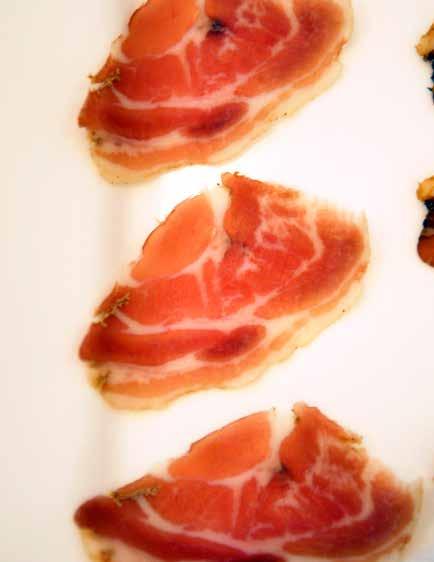 Bartlett Durand, Conscious Carnivore
Bartlett Durand, Conscious Carnivore
22 Summer 2020
7The Challenges of Local Slaughtering and Butchering
issue No. 19 , WINTER 2014
then
An environmentally sound meat supply chain relies on an important link: local slaughtering and butchering. But regulations favoring large processors are expensive and burdensome for small businesses; and no one wants a local slaughterhouse and processing plant in their “backyard,” no matter how small or responsibly run.

“ Attempts to clean up the industry have resulted in increased regulations that, instead of providing transparency for consumers, reward big over small, often hurting those who raise, slaughter and process animals on family farms and in small community butcher shops,” wrote author Jessica Luhning in 2014.
This well researched article provided an in-depth look at the highly contentious closing of Black Earth Meats and Bolzano Artisan Meats—and at what happened to bring these successful and respected businesses to their knees in 2014, leaving more than 200 farmers, 50 employees and 50-plus retailers and restaurants high and dry. We were thrilled when the hard work on this story was recognized with the Edible Communities’ 2015 EDDY Award: Critics' Choice in the Feature Article-Food Artisan category.
Now
Although the Dane County Circuit Court initially ruled in favor of Black Earth Meats, a state appeals court overturned the ruling in 2016. Black Earth Meats appears to be closed for good, and founder Bartlett Durand is focusing his time on the whole-animal butcher shop Conscious Carnivore in Madison. The shop continues to hold strong to its values of “Respect for every animal on four feet or two” and local, sustainable sourcing.
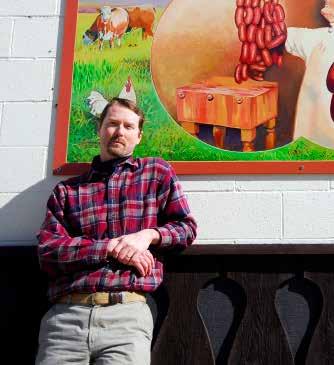
Today as well as in 2014, it’s clear that being a small processor/butcher continues to be a difficult niche, even in Madison, a city more interested in where its food comes from than most. Notably, Underground Butcher on Willy Street closed its doors in December 2019, though not due to regulatory issues. Farther west in our region, near VIroqua, neither Premier Meats nor Driftless Meats found success. But there are still those working hard to connect the dots between local farms and you, like Conscious Carnivore, Bucky’s Butchery on the UW-Madison campus, and Prem Meats and Natural Harvest, both in Spring Green.
Future
COVID-19 disrupted the meat processing industry this year when hundreds of plant employees tested positive for the virus, prompting shutdowns across the Midwest, including at the JBS Packerland plant in Green Bay. The resulting shortages revealed the vulnerabilities of large-scale industrial meat production and processing and have spurred interest in locally sourced options Not only are small-scale, locally focused food systems more flexible and nimble, making them less likely to break down in the wake of unexpected and widespread upheaval, smaller processors are better able to follow pandemic guidelines and may offer safer conditions for workers.
As demand for local meat skyrockets, small farms, processors and butchers are expanding production as much as they can.
Yet despite the clamor for local meat during and following the crisis, it’s difficult to predict whether the demand will remain vocal enough and long-term enough to compel regulators to update meat processing regulations to account for small processors’ fundamentally different scales, values and supply chains.
It’s a partnership between farm and consumer, with small processors—a vital link in our local food system—in the middle. Yet the health of the system is primarily driven by consumers: how loud our voices are and where we put our dollars. That said, consumer research shows that even when meat eaters claim to support small business and value humanely raised and slaughtered meat, their spending patterns don’t often reflect those values. Are we ready to finally walk the talk? Will the COVID-19 crisis solidify the need to address this vulnerability in our consolidated industrial food infrastructure? We hope so. The future of small, sustainable, responsible meat production depends on it.
ediblemadison.com 23
Original article by Jessica Luhning
Original articles: Caring for Wisconsin’s Cold Waters by Jessica Luhning

The Water Behind Your Meat and Potatoes by Tamara Dean
A Farming Resurrection: Aquaponics in Wisconsin by Jeremiah Robinson
Luna B. Leopold
Water Exploring Fresh Water Protection in our region and the economic and environmental impacts on our food system issue no 20, Spring 2015
“ Water is the most critical resource issue of our lifetime and our children’s lifetime. The health of our waters is the principal measure of how we live on the land ”
24 Summer 2020 8
Then
Photographer Jim Klousia captured the Water Issue cover image by pouring a dyed glycerin solution into a nano fish tank and then inverting the photograph. Of the 874 high-speed images shot (the most for any Edible Madison cover), number 779 best reflected the intended symbolism of evaporation. It expresses a message about our responsibility to conserve and protect one of our most important and fragile natural resources before it slips away.
Now
The three articles in this water-themed issue addressed three very different aspects of water usage in Wisconsin five years ago, and their information and messages are still relevant today.
Although aquaponics was developed by the Aztecs long before colonization, it’s still considered an emerging industry. Water-based farming has great potential to produce large volumes of food in much less space; however, it requires a lot of energy, and recently there have been debates around whether it should be eligible for organic certification when it doesn’t use soil.
According to the Wisconsin Department of Natural Resources, “fishing generates $2.3 billion economic impact” in the state, and a large portion of that money and labor goes back into conserving our waterways. However, many of our valuable Class 1 trout streams continue to be threatened by suburban and industry encroachment and loosening environmental oversight.

The literal “meat and potatoes” of the issue was a heavily researched article that called attention to not only the staggering quantity of water that goes into raising our food, but also the steps conscientious farmers are taking to reduce their water usage. Grazing, in particular, can greatly reduce water usage while absorbing rainfall better than hard-packed cropland.
Future
There’s no question that our local waters remain in jeopardy as climate change pushes temperatures upward. The U.S. Environmental Protection Agency wrote in 2016 about Wisconsin’s potential climate change impacts: “Rising water temperatures will increase the available habitat for warmwater fish such as bass, while shrinking the available habitat for coldwater fish such as trout.” Our wettest days of the year are 35 percent wetter, increasing the likelihood of catastrophic flooding. In short, the agency predicts greater unpredictability. Many scientists believe our planet has already passed the point of no return, making it all the more important for farms and resource management organizations to embrace techniques that improve climate adaptability and resilience.
On a positive note, the Great Lakes Compact ensures that lakewater will not be diverted outside the Great Lakes basin, protecting the fishing and shipping industries that rely on these waters. Governor Evers’s declaration of 2019 as “the Year of Clean Drinking Water” kickstarted the development of new water quality protections that had stalled during the Walker administration, and spurred a mostly bipartisan $10 million water quality package that passed the Assembly in early 2020. The legislation represents excellent progress, although it still has to make it through the Senate and to the governor. Looking to the future, the Yahara CLEAN Compact to improve and protect the Yahara River watershed expects to release an action roadmap in 2021.
It’s vital for citizens to be aware of the existing and changing regulations, legislation and nongovernment work that will affect the quality of our local water supplies for generations to come.
ediblemadison.com 25
photos by David Nevala
Embrace the Darkness
Then
Eating locally during Wisconsin winters isn’t easy. Canning, putting up storage crops, and buying meat in bulk are excellent options, but they’re not for everyone. Many of us need local producers and specialty products to fill the gaps. In this winter issue, we celebrated the dark foods and drinks that nourish and comfort during this season of darkness.
One of those specialty products is as dark as they come: black garlic. It’s fermented using a very precise method, turning cloves from creamy white to pitch black and creating a flavor that we struggled to describe.
Author Andy Radtke wrote, “It’s downright candy, grown-up Gummy Bear. Soft and smooth as canned pear with an umami flavor that harkens licorice, date, and well, the polite side of garlic.” Our editor-inchief Jamie Lamonde put it more simply: “...one of the most insanely delicious flavor experiences ever.”
Now Five years later, Hillsboro-based Black Garlic North America (BGNA) is thriving and remains the largest producer of black garlic in the country. In fact, we mentioned them again in our Cooking Fresh column in winter 2019 along with Menn’s Organic Garlic, a small farm also in the Driftless area that might soon rise to compete on the local market. Since we last spoke to BGNA, they’ve added certified organic black garlic to their offerings.
Issue No. 23, Winter 2015
Original Articles: Garlic’s Fermentation innovation by Andy Radtke
Embrace the Darkness: Pair Up with Porter by Tracy Phillippi
In Praise of Braising by Terese Allen About the Cover
Photographing this porter beer on a jet-black background was a challenge, but photographer Jim Klousia was up for it. The lighting had to be just right. Not only that, it was difficult to print on our matte cover paper. The effort paid off though: we were thrilled and honored to receive Edible Communities’ 2016 EDDY Award for Best Cover: Critics' Choice.
While home cooks may not be creating black garlic in their kitchens, interest in other kinds of fermentation is growing. Pickles, kimchi, sauerkraut, sourdough: the art of fermentation is the perfect pastime for cold winter days.
Future
As climate change continues to warm our Wisconsin winters, we’ll see not only more frost-free days and longer growing seasons, but also an increased chance of extreme weather events that could destroy a farm’s livelihood in a single moment.
However, advancements in food and farming research and technology are improving farmers’ abilities to bring fresh, local foods to our tables even during the darkest season. Local farms and producers, such as Enos Farms, Pasture and Plenty, and Bushel & Peck’s, are diversifying to provide microprocessed foods. Hydroponic and aquaponic growers like Superior Fresh, and Clean Fresh Food are disrupting unsustainable food systems to produce greens and fish right here in Wisconsin. Farms are extending their seasons with hoop houses and greenhouses. And winter markets are bringing local farms and local eaters together, providing places of warmth and connection during winter months. It’s a wonderful web of local foods that will keep growing as we continue supporting our hard-working local farms.
 Daunting and Delicious: Eating Locally through Frigid Wisconsin Winters
Daunting and Delicious: Eating Locally through Frigid Wisconsin Winters
26 Summer 2020 9
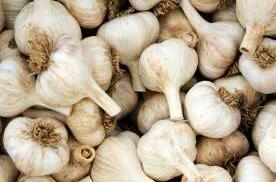
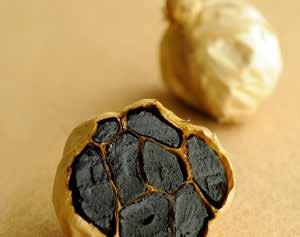
ediblemadison.com 27
“Winter is a tough deal. You know the routine: glacial blasts, hostile sidewalks, the interminable search for mittens. But the stuck-inside season has its upsides, too .” –Terese Allen
Our Restaurant Community
Resilience in the Face of a Pandemic
Then
About the Cover
The gorgeous quail egg raviolo with ricotta, pickled shallot and quail jus on this issue’s cover was part of our Back of the House photo essay featuring Chef Luke Zahm and his team at Driftless Café. Not only was the food photogenic, but Driftless Café had a beautiful story of blending simplicity and innovation, of intertwining relationships and community spirit. Zahm has deep roots in the Driftless region, and his big heart draws people in. He and his team are a prime example of how the restaurant community in our region collaborates to entertain, teach, and celebrate our abundance of local foods.
Now
Without a doubt, COVID-19 has upended our restaurant community. Businesses closed, workers were laid off, and government aid ran out of funding within weeks. Many establishments immediately shifted their business models to contactless options in order to remain open. For others, even the most creative adjustments couldn’t create an economically viable path forward. Restaurants are a key link in our local food economy, so it’s been heartbreaking to watch these pillars of our communities struggle as they have this year. We grieve the loss of restaurants that are closed indefinitely, the lost experience of collective dining, and especially the human impact on chefs and restaurant workers. No matter what happens, we stand with them and will support the recovery in whatever way we can.
Issue No.25, Summer 2016
Back of the House: Driftless Café by Vanessa Herald
Future
There’s a national conversation happening in the media about the future of restaurants and dining culture. Predictions abound, but we went back to Chef Luke Zahm to see what his thoughts were on the future of his industry post-COVID-19.
“Our industry doesn’t have a safety net,” Zahm says. There are labor shortages, mental health and addiction issues, lack of health insurance, and inequities in the entire system. Many restaurant owners don’t have access to unemployment compensation like their staff do, making them even more vulnerable during this time. “COVID is giving a really hard look at what’s happening in the restaurant industry for once. I think there’s a lot of opportunity to create more equity through this.”
Looking forward, Zahm says that only between 15 and 40 percent of restaurants are expected to survive, which means a huge number of people trained in the culture of hospitality will be looking for work this year—and perhaps a positive evolution in dining culture will come from new entrepreneurs entering the scene. “Hospitality is art,” Zahm says “It’s about making people feel seen, feel valued, feel loved, feel at home. This is the time when people who foster those experiences come into their own.”
Vanessa Herald
“So much of the magic of this place begins before the ingredients even hit the kitchen.”
28 Summer 2020
“One of the most painful parts of living through this pandemic is the swift and devastating impact it’s had on our local restaurant community. Their loss is our loss. Independent restaurants are living expressions of the unique soul of our region. They’re a key conduit in the web of farmers, producers, food workers and eaters that make up our local food system. We’re dedicated to do all we can to support our restaurants and we hope you are too.”
 Lauren Langtim, new Managing Editor
Lauren Langtim, new Managing Editor
10 ediblemadison.com 29
Finally, in the midst of real and potential food shortages, Zahm says, “There’s so much security living in the Driftless region. We have farms, we have cooperatives, we have businesses that figure out how to connect, and educate, and create relationships with their foodshed. We’re struggling, sure, but we have the blueprint. This is the power of resilience.”




It’s still too soon to predict the full impact of the recent economic and cultural shifts, but we at Edible Madison have been moved by the creative, positive actions individuals and restaurants have taken to cultivate continued connection, from a distance. We call on our readers to make a point this summer to support your favorite restaurants regularly and generously, in whatever way you can. Get takeout, purchase gift cards, participate in “special event” curbside pick-up meals, buy meal kits, contribute to virtual tip jars. If you see a restaurant doing something especially neat, please share it with us at hello@ediblemadison.com; we’ll consider spreading the news to our social media followers. And remember to use your voice and your votes! Contact your legislators and urge them to support providing critical aid to small businesses.
Our restaurant scene may not emerge from the pandemic looking the same as it did before, but we have faith that it will bounce back— especially with strong support from our community of food lovers.
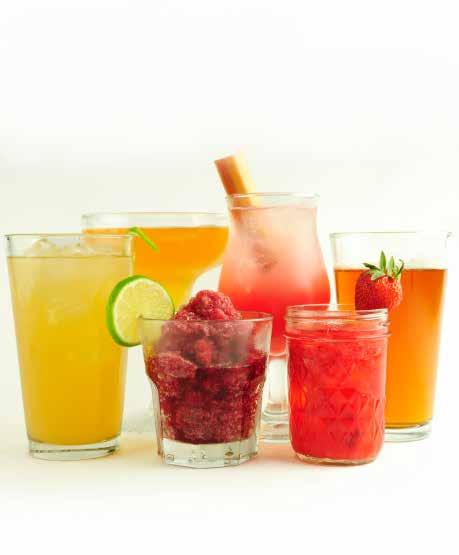

Join us for virtual foo die happy hours Follow us to keep up on Events, news and more! @ediblemadison • facebook.com/EdibleMadison 30 Summer 2020
Celebrate Edible's 10th Anniversary All Year Long
“The experience we’re trying to create is one of community, sustainability and hope. People need something to believe in, something not wrapped in smokescreens or politics. COVID has pushed me to be that model of transparency and communication, to take no excuses. I’m more dedicated to those principles now than I was before. I have no doubt that things will change, but I know in my heart of hearts, we will survive.”
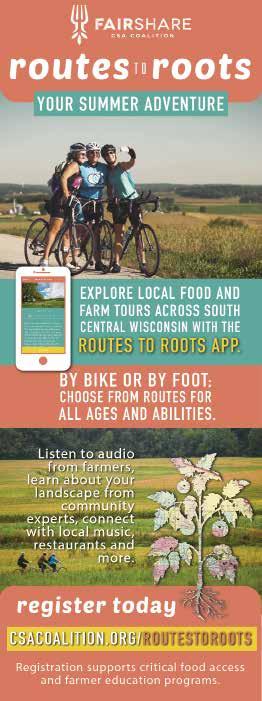
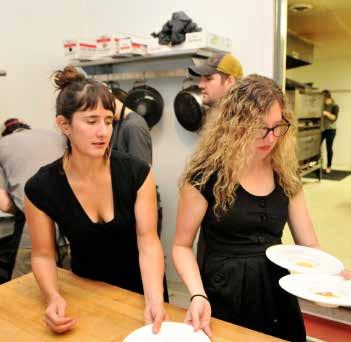
ediblemadison.com 31
Luke zahm, Owner Driftless Cafe
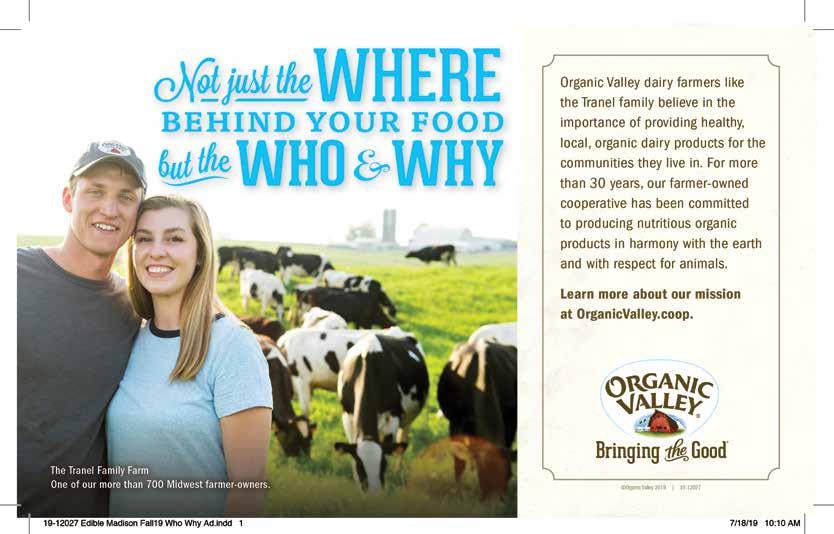
32 Summer 2020

Aronia Berry Buckwheat Sourdough Waffles recipe roundup
We've pored through past issues to select ten recipes that we hope will bring you a bit of joy and comfort. Use whatever’s in season and enjoy alfresco! 10 years of delicious 1 Choux Puffs with Slow-Scrambled Eggs & Morels 2 Aronia Berry Buckwheat Sourdough Waffles 3 Cilantro Frittata with Pea Shoots & Feta 4 Cucumber, Corn & Mint Salsa 5 Zhoug 6 Jujukh 7 KC Meets Wisco BBQ Sauce 8 Raspberries with Currant-Honey Coulis 9 The Starkberry 10 Chocolate Beet Cake all photos by Jim Klousia ediblemadison.com 33
from the archives
Choux Puffs with Slow-Scrambled Eggs & Morels
 By Terese Allen - Spring 2017 Issue Serves: 10 • Prep Time: 15 minutes• Cook Time: 30 min
By Terese Allen - Spring 2017 Issue Serves: 10 • Prep Time: 15 minutes• Cook Time: 30 min
Pâté a choux is the French term for the pastry used to make cream puffs, one of Wisconsin’s most beloved desserts. Easy to make, and able to attract as much attention as a spring bride, the shells work equally well with savory fillings.
Ingredients
6 Tbsp. butter, divided ½ to ¾ lb. fresh morels (or substitute white mushrooms), cleaned and cut in half if large Salt and pepper 1 dozen large eggs ½ cup heavy cream
3 Tbsp. finely chopped ramp leaves, green garlic or chives 8 choux puffs
Directions
Make choux puffs (see recipe http://ediblemadison.com/recipes/ view/choux-puffs).
Melt 3 tablespoons butter in one very large or two large skillets over fairly high flame. When butter begins to sizzle, add mushrooms, but don’t crowd the pan(s). Sauté until mushrooms are tender and any liquid has cooked off. Season with salt and pepper. Turn off heat and keep warm.
Beat eggs, cream and more salt and pepper in a bowl. Melt remaining butter in a large nonstick skillet over very low flame. Add eggs and cook very slowly, stirring occasionally, until eggs are nearly set, 15 to 20 minutes.
Stir in mushrooms and ramps (or other green things). Continue to cook slowly until eggs are set.
Split the puffs in half horizontally, fill bottoms with cooked eggs and place tops back atop puffs, ajar. Serve immediately. (They can also be kept for 10 minutes or so in a warm oven.)
Suggestions
Choux puffs can be made ahead, frozen for up to two months and re-crisped in a warm oven. Some cooks will also freeze the unbaked puffs and then pop them into a hot oven directly from the freezer.
34 Summer 2020
Aronia Berry Buckwheat Sourdough Waffles or Pancakes
By Dani Lind - Summer 2016 Issue
Serves: 8 / Prep Time: 15 minutes plus 12-36 hours inactive time / Cook Time: 15 minutes
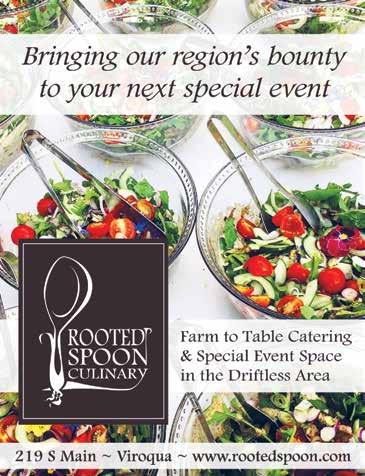
This versatile recipe can be used to make waffles or pancakes. Although the yeast batter takes a bit longer to prepare, the flavor is like nothing you’ll get from a quick-prep batter!
Ingredients

8 Tbsp. unsalted butter (1 stick)
2 cups milk
1¼ cups buckwheat flour
¾ cup all-purpose white flour (or 1-to-1 gluten-free flour mix)
1½ tsp. instant yeast
¼ tsp. salt
2 eggs
2 Tbsp. maple syrup or honey
1 tsp. pure vanilla extract
1 cup aronia berries (fresh or frozen)
Suggestions

Don't have aronia berries? Any summer berry can be substituted in this recipe. We highly recommend blueberries, which have a similar texture to aronia berries, but raspberries, blackberries, currants and chopped strawberries will do in a pinch as well.
Directions
Melt butter in a small saucepan. Add milk and heat until body-temp warm.
In a large bowl, whisk together flours, yeast and salt.
Whisk in warm milk-butter mixture until smooth. In another bowl, whisk together eggs, maple syrup and vanilla, and whisk this into batter.
Cover and refrigerate overnight or longer (12 to 36 hours seems best).

When ready to make waffles or pancakes, carefully fold in aronia berries. Pour amount of batter appropriate to your preheated, well-greased waffle maker (mine takes a cup) or skillet. For pancakes, flip when edges are dry and cook on other side.
Serve your waffles or pancakes immediately with maple or aroniamixed-berry syrup.
ediblemadison.com 35
Cilantro Frittata with Pea Shoots & Feta
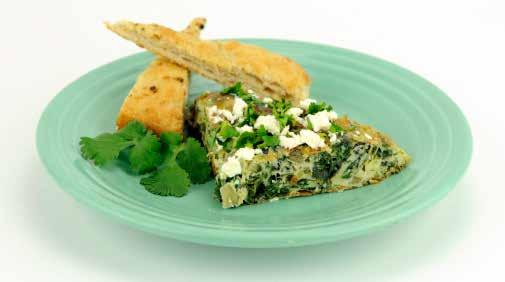 By Terese Allen - Spring 2016 Issue
By Terese Allen - Spring 2016 Issue
Serves: 4 • Prep Time: 20 minutes • Cook Time: 10 minutes
Ingredients
8 large eggs
4 Tbsp. coarsely chopped cilantro, divided Salt and pepper to taste
3 Tbsp. butter, divided
¼ cup finely chopped spring onions (or ¼ cup chopped green onions)
4 cups coarsely chopped pea shoots
3/4 cup crumbled sheep’s milk feta
Foods that grow together in the garden go together in the kitchen. Here’s a dish that is delicious proof.
Directions
Beat eggs in a bowl with 3 tablespoons of the cilantro, salt and pepper. Set aside.
Melt 1½ tablespoons of the butter over medium-high flame in 9- or 10-inch nonstick skillet. When butter begins to foam, add onions and cook a minute or two. Add pea shoots; cook, stirring often, until greens wilt, 2 to 4 minutes.
Reduce heat to medium-low and stir in another tablespoon of butter. Stir in eggs, cover pan and cook until the eggs are mostly set, 8 to 10 minutes. (The top will still look a little wet at this point.)
Use a rubber spatula to shape and smooth outer edges of frittata to form an attractive round. Slide spatula underneath the frittata to loosen it. Carefully glide frittata onto a platter, guiding it with the spatula.
Add remaining ½ tablespoon butter to pan. Wearing oven mitts, invert the hot pan over the top of the frittata (don’t worry; the melted butter will drip onto the frittata). Grasp the pan-platter construction with both hands to hold it together and then flip it upside down. The frittata will now be back in the pan on its second side. Sprinkle with feta and return it to the heat for a moment or two to finish cooking.
To serve, loosen frittata from the pan and slide it back onto the platter. Sprinkle with remaining cilantro. Serve it hot, warm or at room temperature.
36 Summer 2020
Cucumber, Corn & Mint Salsa
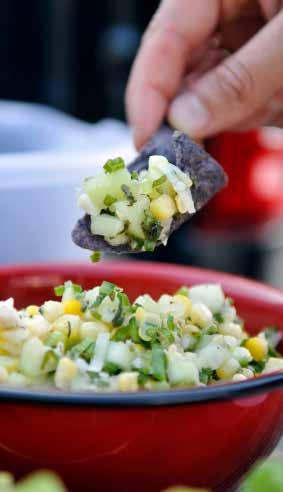 By Dani Lind - Fall 2016 Issue
By Dani Lind - Fall 2016 Issue
Serves: 16 • Prep Time: 15 minutes • Cook Time: 5 minutes
Ingredients
2 medium cucumbers
3 ears sweet corn
1 small bunch scallions (white and green parts), chopped
1 to 2 jalapeño peppers, seeds removed, finely chopped (to taste)
1/3 cup coarsely chopped fresh spearmint (do not use dried)
2 cloves garlic, smashed and minced
2 Tbsp. local cold-pressed sunflower oil
Zest and juice of 1 lime
Salt and pepper to taste
Directions
Peel cucumbers, cut in half lengthwise and scoop out seeds with a small spoon. Cut into small dice and place in a medium bowl.
Cook sweet corn (preferably grilled!). Allow to cool, then cut corn off the cob into bowl with cucumbers. Add all remaining ingredients and adjust seasonings to taste.
Suggestions
Serve with chips or alongside grilled fish, chicken, lamb or vegetables. You can also fold in cubed avocado.
This fresh salsa makes use of sweet corn and cucumbers that are plentiful during mid- to late-summer—perfect for a hot and lighthearted pre-season game.
ediblemadison.com 37
Zhoug
By Dani Lind
Prep: 5 minutes / Makes: about 2 cups
ingredients
5 to 10 mildly hot small green peppers such as jalapeno or serrano, stems removed (remove seeds for even less heat)
3 to 4 medium cloves garlic
1 medium bunch cilantro, leaves and upper stems coarsely chopped
1 medium bunch flat-leaf parsley, leaves and upper stems coarsely chopped
Juice and zest from half a lemon
2 tsp. ground cardamom
2 tsp. ground coriander
1 tsp. kosher sea salt
2/3 cup olive or local sunflower oil
Directions
Combine all ingredients except oil in a food processor and pulse into a coarse paste, scraping down the sides once or twice. Add oil until just incorporated— you want the sauce to be a bit chunky, not totally smooth. Adjust seasoning to taste. Keep in a sealed jar in the refrigerator for a week or two, or freeze in airtight containers.
Use this sauce to top grilled vegetables, chicken, fish, lamb or any kind of pita sandwich. Add to regular hummus for a spicy green version, or mix with yogurt (to cut the heat) for a tasty dipping sauce.
Suggestions
While commercially ground spice is delicious in this recipe, you can up the ante by toasting whole cardamom seed (not whole green pods) and coriander seed in a dry skillet, then grinding in a spice or clean coffee grinder.
Pronounced “Zoog,” also spelled Schug, this is a beautiful, green, Yemenite sauce now popular in much of the Middle East. Make it milder or spicier by changing the quantity and variety of hot peppers.

38 Summer 2020
Jujukh
By Terese Allen - Summer 2016 Issue
Serves: 6 / Prep Time: 15 minutes
Ingredients
4 cups plain Greek-style yogurt
2 tsp. finely minced garlic, mashed to a paste with flat of a knife
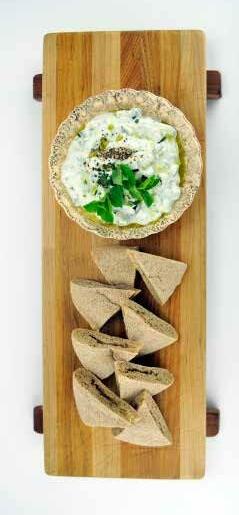
2 medium or 4 small cucumbers, peeled (or not), seeded and diced
4 Tbsp. chopped fresh spearmint
Salt and pepper
2 Tbsp. extra virgin olive oil
Directions
Whisk yogurt, garlic and ½ cup cold water in a bowl. Stir in diced cucumbers and most of the mint, plus salt and pepper to taste. Swirl in olive oil and sprinkle with remaining mint.
Enjoy this versatile (and super-easy) preparation as a salad or side dish, a bread dunk or sauce for rice pilaf. To turn it into a cooling summer soup, stir in crushed ice a few minutes before serving.
ediblemadison.com 39
KC Meets Wisco BBQ Sauce
By Laura Poe Mathes - Summer 2019 Issue
Makes 3 cups / Prep Time: 15 minutes / Cook Time: 40 minutes
Ingredients
1 Tbsp. olive oil or cooking fat of choice
1 cup yellow onion, diced
2 Tbsp. garlic, minced
1 cup tomato paste
2/3 cup apple cider vinegar
1/3 cup sorghum molasses
1/3 cup real maple syrup
1/3 cup Dijon mustard
1/3 cup plus 1 Tbsp. soy sauce
1/3 cup brewed coffee
1 ½ tsp. paprika
½ tsp. cumin powder
½ tsp. chipotle powder or smoked paprika
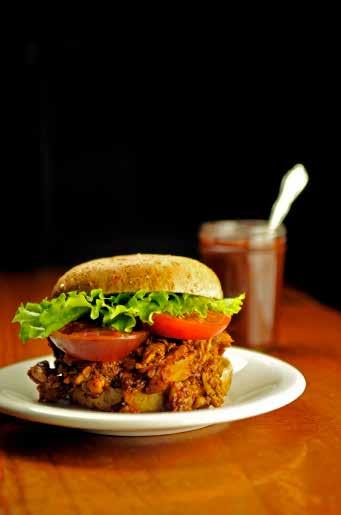
½ tsp. sea salt
¼ tsp. cayenne, or to taste ¼ tsp. black pepper
Directions
In a medium pot, heat olive oil (or cooking fat of choice) over medium heat. When the oil is hot, add the onions and cook for about 5 minutes, until they begin to sweat. Add the garlic and cook 3 to 5 more minutes. Add all remaining ingredients, whisking well to combine. Let come just to a boil, stirring regularly to prevent sticking, and reduce the heat to low. Let simmer for 20 to 30 minutes until thickened slightly.
Let cool and store in the refrigerator for about two weeks. This is even better a few days after making it, if you can wait that long.
Suggestions
The Wisconsin twist is using local sorghum molasses and maple syrup as the sweeteners, which are both unrefined and rich in minerals, making this healthier than store-bought barbecue sauces that typically contain high fructose corn syrup. You can go the extra-local step and use a locally roasted coffee here as well, such as Wonderstate Coffee or Kin Kin Roasters.
Got a zucchini blitz going on in your garden? You can serve this pasta dish over and over by varying it with different herbs and cheeses.
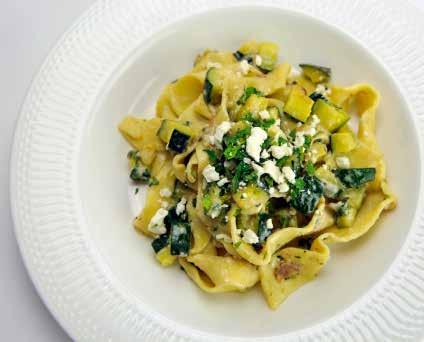
40 Summer 2020
A Wisconsin-ized version of a Kansas City-style BBQ sauce that is tomato- and molasses-based with a kick of smoke and spice to balance out the sweetness and acidity.
Pappardelle with Creamy Zucchini, Feta and Mint
By Terese Allen - Summer 2016 Issue
Serves: 2 /Prep Time: 20 minutes / Cook Time: 15 minutes
Ingredients
4 Tbsp. olive oil
3 Tbsp. thinly sliced shallots
3 garlic cloves, thinly sliced
1-½ pounds small zucchini, cut into ½-inch dice Salt and pepper
2/3 cup 2% or whole milk
1 package (12 oz.) fresh lasagna sheets, cut lengthwise into ½-inch-wide strips (see suggestion)
2 to 3 Tbsp. chopped fresh mint ½ cup crumbled feta
Directions
Bring a pot of salted water to boil. Meanwhile, place olive oil, shallots and garlic in a large, heavy skillet. Place over medium-low flame and let it heat up. Cook, stirring occasionally, until shallot and garlic are sizzling and softened.
Add zucchini plus a generous seasoning of salt and pepper. Raise heat to medium and cook, stirring occasionally, until zucchini starts to soften, 5 to 8 minutes. Stir in milk; continue to cook, stirring often, until zucchini is fully tender, about 5 minutes more.
While the zucchini is finishing, add pasta to the boiling water; cook until barely tender. Drain pasta and toss it with the zucchini mixture, mint and feta. It will absorb any remaining liquid. Add more salt and pepper as desired. Serve pronto.
Suggestions
Terese recommends local RP’s Pasta Company’s fresh lasagna sheets for this recipe.
Stellar cheese-and-herb combinations include Hook’s Gorgonzola with tarragon, Sartori’s BellaVitano Gold with basil, and Capri Cheese’s sheep and goat milk chevre with dill.
Raspberries with Currant-Honey Coulis
By Terese Allen - Summer 2017 Issue
Serves: 8 / Prep Time: 25 mins plus 12-24 hours resting time
Ingredients
1 cup heavy cream
1 cup sour cream
1 quart red currants
1/3 to ½ cup honey, divided Fresh raspberries or a mix of any summer berries Mint sprigs
Directions
Crème fraiche: Combine heavy cream and sour cream in a glass bowl. Whisk until smooth. Cover with plastic wrap, set in a warm place and let stand until thickened, 12 to 24 hours. Stir, cover again and chill completely.
Coulis: Cook currants in water to barely cover until they burst. Strain through a sieve lined with dampened cheesecloth, gently squeezing out as much liquid as you can. Gently boil currant juice and 1/3 cup honey until reduced by about half. Stir in more honey to taste. Chill the sauce.
To serve: Portion berries and some of the coulis into individual serving dishes or glassware. Add a dollop of crème fraiche to the top of each dish, then a little more coulis over that. Garnish with mint sprigs.

Suggestions
Make the crème fraiche and coulis a day or two ahead; they’ll keep a week or more in the fridge, to be at the ready when you bring home the berries.
Tangy crème fraiche and pureed red currants with honey make a simple yet luxurious combo to set off summer berries.
ediblemadison.com 41
Chocolate Beet Cake
By Dani Lind, Rooted Spoon Culinary - Summer 2015 Issue Serves 10 / 20 Minutes Prep Time, 45 Minutes Cook Time
Ingredients
2 ½ cups beets, cooked, pureed and cooled 6 eggs, lightly beaten ¾ cup unsweetened cocoa powder
1 tsp. vanilla 2 cups sunflower oil 3 cups sugar
3 ¾ cups all-purpose white flour, sifted 1 ½ tsp. salt
1 tbsp. baking soda
Directions
Preheat oven to 350 degrees. Grease 3 eight-inch or 2 nine-inch baking pans and line with parchment. (You may have enough batter left over to make a couple cupcakes.)
In large bowl or stand mixer with paddle attachment, combine cocoa, vanilla, and oil. Beat in beets, sugar, and eggs.
In a separate bowl, sift together flour, salt and baking soda.
Add wet mixture and mix until well incorporated. Pour into pans and bake 30-45 minutes (depending on pan size), until toothpick comes out clean in middle.
Cool completely on racks before frosting.
Suggestions
Top off this recipe with Dani's Easy Chocolate Frosting.

This recipe pairs well with Wollersheim Winery's Port, which is made from Foch grapes and grape brandy and aged in older American oak barrels for 13 months. The brandy is added to stop the fermentation, which leaves the natural sweetness of the grapes.
Project Congo, Kickapoo Coffee's philanthropic Congelese coffee, pairs beautifully with the earthy spice of the Chocolate Beet Cake.
This rich, decadent cake may not be low in calories, and it's not Ms. Edna Davis's (see the last bite), but you can feel a little better knowing you ate some vegetables.
Frosting Ingredients
¼ pound butter, softened 4 oz. cream cheese, softened 1 tsp. vanilla 1 cup powdered sugar ½ cup unsweetened cocoa powder
Directions
Cream the butter and cream cheese until fluffy. Mix in vanilla.
Sift together sugar and cocoa then slowly whip into frosting until smooth.
42 Summer 2020
The Starkberry
By Ryan McCormick of Restoration Cider Co. Summer 2016 Issue


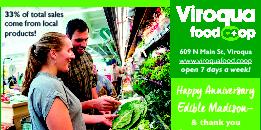
Serves: 1 / Prep Time: 2 minutes
Ingredients
2 oz. Mathilde Framboise or any raspberry liqueur*
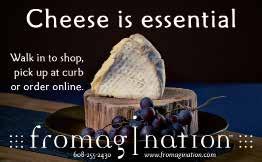
4 oz. Restoration Cider Starkweather Mint leaf or sprig for garnish
Optional: macerated raspberries as a bottom-of-glass garnish
Directions
If using macerated raspberries, first place a spoonful in bottom of glass, being careful to not stir up raspberries. Pour raspberry liqueur, then cider into a tulip glass and stir. Garnish with mint leaf or sprig.

Suggestions
While red raspberry is preferred, Chambord will do as a last resort.
This cocktail combines Restoration Cider Starkweather with raspberry liquor for a most refreshing summertime drink.
ediblemadison.com 43
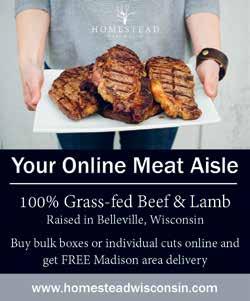












local marketplace 44 Summer 2020


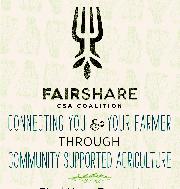



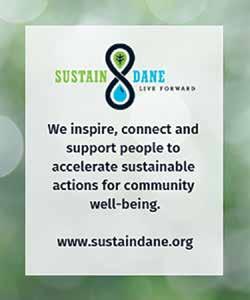




local marketplace ediblemadison.com 45
THANK YOU TO OUR ADVERTISERS!
Please support the following businesses to experience the best local, seasonal, and sustainable products and services in the region.
Business & Consumer Services
Heartland Credit Union heartlandcu.org
Karen Innis Century 21 Affiliate 608-799-1338
Catering Rooted Spoon Culinary 219 S. Main St., Viroqua 608-632-2120 rootedspoon.com
Kitchen & Tabletop
Convivio
122 North Lexington Street, Spring Green convivioshop.com
PostKnife
608-285-2623 postknife.com
Farms & Farm Goods
Homestead Wisconsin Belleville 608-712-0997 homesteadwisconsin.com
Food, Agricultural & Sustainability Organizations
FairShare CSA Coalition
303 S. Paterson St., Ste. 1B, Madison 608-226-0300 csacoalition.org
REAP Food Group
306 E. Wilson St., Ste. 2E, Madison 608-310-7836 reapfoodgroup.org
Slow
Food-Madison
slowfoodmadison.org
Sustain Dane
211 S. Paterson St., #200, Madison 608-819-0689 sustaindane.org
Valley Stewardship Network
124½ South Main St., Viroqua 608-637-3615 kickapoovsn.org
Food & Beverage
Island Orchard Cider 12040 Garrett Bay Rd., Ellison Bay 920-854-3344 islandorchardcider.com
Organic Valley
1 Organic Way, La Farge 888-444-MILK organicvalley.coop
The Quince & Apple Company
608-301-5433 quinceandapple.com
Relief Honey
sweetreliefhoney@gmail.com judehotep.com
Roth Cheese
657 2nd St., Monroe rothcheese.com
Grocery Stores & Farmers Markets
Wonderstate Coffee
1201 North Main St., Viroqua 608-637-2022 wonderstatecoffee.com
Dane County Farmers’ Market
Saturday Market on the Square, Saturdays, April 13 - November 16
Wednesday Market, 200 block Martin Luther King Jr. Blvd, April 17 - November 6
Holiday Market, Monona Terrace, Saturdays, November 23, December 7, 14, & 21
For times and more info, (608) 455-1999 dcfm.org
Viroqua Food Co-op
609 North Main St., Viroqua 608-637-7511 viroquafood.coop
Willy Street Co-op
Willy East: 1221 Williamson St., Madison 608-251-6776
Willy West: 6825 University Ave., Middleton 608-284-7800
Willy North: 2817 N. Sherman Ave., Madison 608-709-5445 willystreet.coop Events Wormfarm Institute Presents: Fermentation Fest
September 26-October 4 fermentationfest.com
46 Summer 2020
ediblemadison.com 47
Edible Madison asked me “What’s the cake you crave when you want comfort and a sense of security?” Ahh, celebration and comfort, the magic combo. For me, that cake is beyond any doubt Edna Lewis’s Very Good Chocolate Cake. This cake's crumb is so moist and tender that the layers rarely stack and line up with sharp, instagram-ready posture. The ganache frosting is so rich with cream and coffee it barely sets; the swoops are always a bit beyond control. So it tends not to be the prettiest or the most editorial. But it’s the one I bake for my own birthdays or when I want to celebrate with close friends. It’s the one I bake when the world feels unstable or unkind and I need the sort of reassurance that only PJs, a favorite chair, a large fork and unadulterated chocolate can deliver.
Ms. Lewis’s chocolate cake is a kind of touchstone for me. It’s atavistic. It’s the one I bake when I need grounding, a hug, or a reminder of what I learn every day from Black women. When I bake this cake I remember that true connection, care, and hospitality have always been essential. I remember that solutions can be as much about remembering as innovating. And then I feel better. Hopeful. Such is the power of a very good chocolate cake.

Some days it seems 2020 has brought us nothing but instability. This has jolted many of us awake and sent us scrambling to find our entry point in a continuum: those of us awake become better listeners who become allies who then become co-conspirators. Edna Lewis’s Very Good Chocolate Cake is the cake I’ll bake when my fellow co-conspirators come over to plan and scheme and dream. When we need very good fuel for the work ahead.
Monica O'Connell Baker/ Cake Designer @curtisandcake PGPs: she/her/hers
last bite
photo by Tracy Harris




































 Adrian Lipscombe
Adrian Lipscombe





 Left (top to bottom) Jessica and Erika Jones of Giant Jones, Staff Cleaning tanks at Lake Louie, Tom Porter, owner of Lake Louie Brewing with staff.
Left (top to bottom) Jessica and Erika Jones of Giant Jones, Staff Cleaning tanks at Lake Louie, Tom Porter, owner of Lake Louie Brewing with staff.


 Shannon Henry Kleiber
Shannon Henry Kleiber














 Bartlett Durand, Conscious Carnivore
Bartlett Durand, Conscious Carnivore




 Daunting and Delicious: Eating Locally through Frigid Wisconsin Winters
Daunting and Delicious: Eating Locally through Frigid Wisconsin Winters


 Lauren Langtim, new Managing Editor
Lauren Langtim, new Managing Editor









 By Terese Allen - Spring 2017 Issue Serves: 10 • Prep Time: 15 minutes• Cook Time: 30 min
By Terese Allen - Spring 2017 Issue Serves: 10 • Prep Time: 15 minutes• Cook Time: 30 min




 By Terese Allen - Spring 2016 Issue
By Terese Allen - Spring 2016 Issue
 By Dani Lind - Fall 2016 Issue
By Dani Lind - Fall 2016 Issue





































